
St Paul's Anglican Church, Maryborough
[Photograph by Simon Colvin (October 2007)]

St Paul's Anglican Church, Maryborough
[Photograph by Simon Colvin (October 2007)]
Historical and Technical Documentation by Geoffrey Cox
© OHTA 2007, 2011, 2017 (last updated April 2017)
The present St Paul's Church was consecrated by Bishop Hale on 30 August 1879.1 The building was designed by the prominent Brisbane colonial architect, F.D.G. Stanley, using a design very similar to the one he had provided earlier for Holy Trinity Anglican Church, Fortitude Valley. It replaced a timber church dating from 1866, which in turn had replaced a timber slab building dating from 1852, having been moved from the 'Old Maryborough Township' site on the north of the Mary River in 1856. The massive detached bell tower, added in 1887, contains a full peal of nine bells cast by Mears White Chapel Bell Founders of London.2
The search for a suitable pipe organ appears to have begun around the time the present church was opened. In September 1880, George Fincham of Melbourne provided an estimate of £453 for a two-manual organ of 15 speaking stops.3 The decision to order the organ from Wadsworth of Manchester was made around Easter 1882, and Stanley was called upon to design a gallery for the west end of the church to accommodate the instrument.4 This was the first of two instruments exported by the Wadsworth firm to Australia, the other being opened in 1887 at the Methodist Church in Goulburn, NSW.5 A third instrument by Wadsworth, imported second-hand, is now located at Westminster Presbyterian Church, Cook, ACT.

The builder's nameplate on the Maryborough organ
[Photograph by Trevor Bunning (October 2007)]
By April 1883 it was estimated that the cost of the Maryborough organ would be around £600, including the price of a hydraulic motor.6 The instrument had been completed in Manchester by November 1883,7 and it arrived in Maryborough early in the following year:
The churches in town are nearly all providing new organs. By the Cildwall a pipe organ costing £300 is being landed. For St. Paul's Church of England a £400 instrument is on board the Earl of Derby, and the Congregationalists have purchased an eighty guinea "Clough and Warren" from Mr. Kaye's warehouse in Brisbane.8
The organ was installed by Mr B.B. Whitehouse of Brisbane and was opened on 24 March 1884.9 Whitehouse was also responsible around the same time for the installation of another Manchester-built organ at Wesley Church, Maryborough,10 which was presumably the pipe organ costing £300 to which reference is made above.
A full report announcing the opening of the St Paul's organ appeared in The Maryborough Chronicle as follows:
The splendid new organ, the finest in the colony, recently imported for St. Paul's church, is now erected in position, and will be used for the first time at a public recital to-night. A neat but substantial gallery designed by Mr. F. D. G. Stanley has been constructed over the main entrance to the Church, and on it the organ has reared its head obedient to the skilful touch of Mr B. Whitehouse, head tuner from the Brisbane Piano warehouse, whose services were specially secured to erect this organ and that at the Wesley Church. That this gentleman has done full justice to the magnificent instruments entrusted to him, is demonstrated by the perfect appearance and tone observable in both. The St. Paul's organ is truly a grand one. Its appearance with elegant polished oak front surmounted with 35 tastefully decorated pipes constituting the front row, adds to the beauty of the church interior, while the volume of sound emitted from the instrument is quite in keeping with the spacious proportions of the sacred edifice. The variety of tones at the command of the organist is both great and beautiful. No less than 24 stops, each one representing a differently constituted set of pipes, are ready to the operator's hand, while combination stops, a pedal octave, and the most effective "swell" which skilful mechanism can produce, are also readily accessible. For the information of our musical readers we append the full synopsis of the instrument:-
1.
2.
3.
4.
5.
6.
7.
8.
9.
10.
11.
12.
13.
14.
15.
16.
17.
18.
19.
20.
21.
22.
23.
24.
GREAT ORGAN.
Open Diapason
Stopt Diapason and Clarabella
Gamba
Dulciana
Principal
Harmonic Flute
Twelfth
Fifteenth
Mixture
Trumpet
SWELL ORGAN
Lieblich Bourdon
Violin Diapason
Hohl Flute
Salicional
Voix Celestis
Girgen Principal
Mixture
Cornopean
Oboe
PEDAL ORGAN
Open Diapason
Bourdon
COUPLERS, &c.
Swell to Great
Great to Pedals
Swell to Pedals
8 feet
8 feet
8 feet
8 feet
4 feet
4 feet
3 feet
2 feet
2 ranks
8 feet
CC to G
16 feet
8 feet
8 feet
8 feet
8 feet
4 feet
2 ranks
8 feet
8 feet
CCC to F
16 feet
16 feet
(grooved bass)
[Flute harmonique]
[sic]
[Hohl Flöte]
(grooved bass)
[Voix Céleste]
[Geigen]
metal
wood
metal
metal
metal
wood & metal
metal
metal
metal
metal
wood & metal
wood & metal
wood
metal
metal
metal
metal
metal
metal
wood
wood
56 pipes
56 pipes
56 pipes
44 pipes
56 pipes
56 pipes
56 pipes
56 pipes
112 pipes
56 pipes
56 pipes
56 pipes
56 pipes
44 pipes
44 pipes
56 pipes
112 pipes
56 pipes
56 pipes
30 pipes
30 pipes
Three Compositions Pedals to Great Organ.
Three Compositions Pedals to Swell Organ.
It will thus be seen that the organ is built with two complete manuals and independent pedals. The builders are Wadsworth and Co, Manchester, and the cost of the organ as it now stands is something over £600. The public of Maryborough, no less than the congregation of St. Paul's, must feel under an obligation to the local church authorities for introducing such a magnificent instrument to the town. The cost is not yet all defrayed, and the organ committee ought not to be disappointed in their hopes that sufficient donations will be tendered at the recitals to-night and Thursday to go a long way towards wiping out the debt.11
The opening of the organ was reported in more detail shortly afterwards in The Queenslander:
Perhaps the largest event of the week is the inauguration of a really magnificent organ at St. Paul's Church. We say it is the premier instrument in the colony; and to show that this it not blow it may be added that impartial visitors make the same proclamation. The assertion, therefore, may be considered as well-established truth. But anyhow our organ involves a bill of costs of over £600, and comes from the famous Manchester makers, Messrs. Wadsworth and Co., with a first-class certificate. It is a grand organ. Two evening recitals of the instrument's power and tone brought together very large audiences, and some £45 to the funds, voluntarily contributed. Messrs P. C. Atkinson, Hutchinson, Bennett, and [Geyger?] were intrusted with the duty of revealing some of the infinite possibilities of harmony which such an instrument contains. Our leading vocalists assisted with oratorio solos, Mrs. Cantrill's rendering of "He was despised" being particularly effective. It is stated that Mr. P. C. Atkinson may become the salaried organist at St. Paul's.12
The gallery position for the organ appears not to have been favourable, and by April 1891 it was reported to be in serious disrepair. It was consequently removed from the gallery, repaired and re-erected by Mr Harpur (presumably a local man) in its present position on the right-hand side of the chancel. A series of recitals was given by Mr Seymour Dicker (the organist of St John's Church in Brisbane), and a marked improvement in the condition of the organ was noted.13
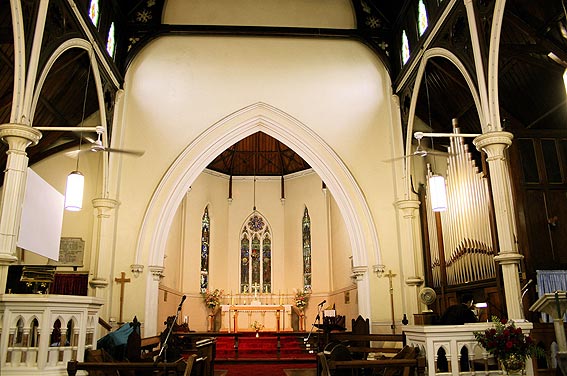
The organ in its present position in the chancel
[Photograph by Trevor Bunning (October 2007)]
The organ was renovated by B.B. Whitehouse & Co. in July 1909, at which time a Tremulant was added, and a Crossley gas engine was installed.14 A new blower was supplied in 1938 by Whitehouse Bros of Brisbane.15
In 1969, the instrument was rebuilt by Whitehouse Bros with electro-pneumatic action using a new stop-key console, and the original slider soundboards were replaced by the cone-pallet type. At the same time, the manual compass was enlarged from 56 notes to 61 notes, and the original Great Trumpet was replaced completely. The show-pipes were repainted by a local firm. Three new pedal stops were added by upward extension from the original two, and the number of couplers was increased to eight.
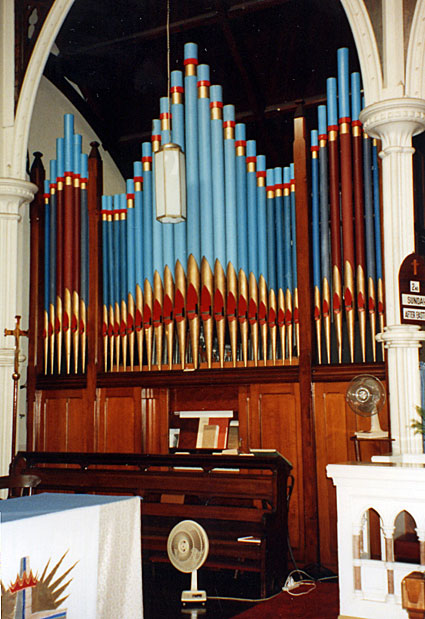
Façade pipes repainted by a local firm in 1969
[Photograph by Howard Baker (1990s)]
| GREAT Open Diapason Clarabella Gamba Dulciana Principal Harmonic Flute Twelfth Fifteenth Mixture Trumpet SWELL Lieblich Bourdon Violin Diapason Hohl Flute Salicional Celeste Geigen Principal Mixture Cornopean Oboe PEDAL Open Diapason Bourdon Bass Flute Principal Fifteenth COUPLERS Great to Pedal Swell to Pedal Swell to Great Swell Super Swell Sub Swell to Great Super Swell to Great Sub Swell Unison Off |
8 8 8 8 4 4 2-2/3 2 II 8 16 8 8 8 8 4 II 8 8 16 16 8 8 4 |
A B B A A |
[replaced 1969] [marked 8ft] [1969] [1969] [1969] [1969] [1969] [1969] [1969] [1969] |
Swell Tremulant
Balanced Swell Pedal
Compass: 61/30
Radiating Concave Pedalboard
4 Combination Pistons to Great
4 Combination Pistons to Swell
Gt & Ped Comb coupled.16
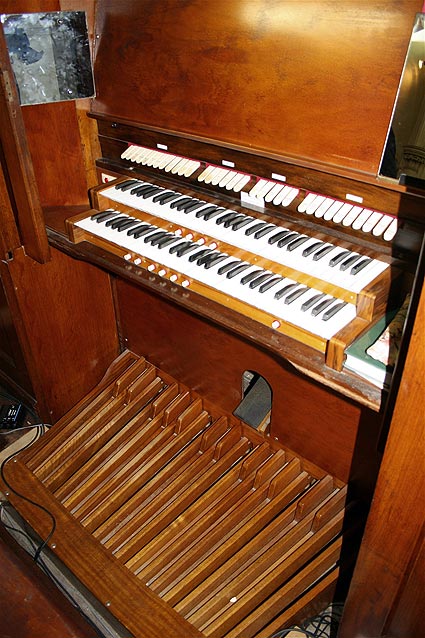
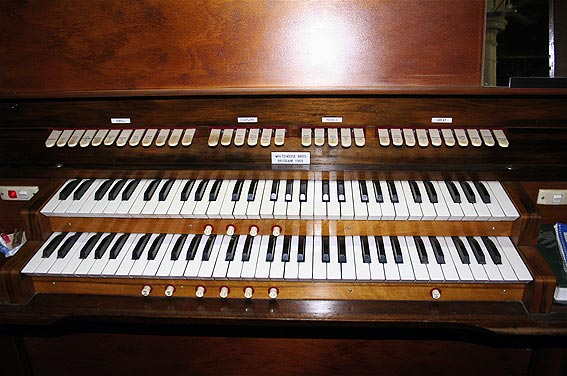

The Whitehouse stop-key console and nameplate of 1969
[Photographs by Trevor Bunning (October 1990)]
The pedal chests were overhauled in 1988 by W.J. Simon Pierce of Brisbane.17 Renovation by Pierce in 1999 included replacement of puffers, general cleaning, the removal of corrosion on the reed blocks, and repairs and repainting of the façade pipes.18
Given that the original action and windchests have been completely replaced, all that remains of the original instrument is essentially the pipework, albeit configured according to the original specification. The successive re-painting of the façade pipes in 1969 and 1999 has removed whatever evidence might once have existed of the 'tastefully decorated pipes' that originally graced the elegant polished oak case.
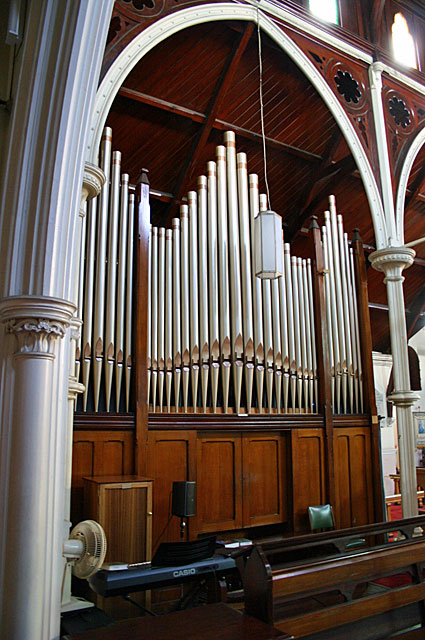
The case of the organ following the renovation of 1999
[Photograph by Simon Pierce (c.1999)]
______________________________________________________________________
1 Pugh's Queensland Almanac for 1880, s.v. 30 August 1879.
2 Queensland Heritage Council, Queensland Heritage Register, location 600705.
3 George Fincham Letter [Specification] Book 13, pp. 104-106 (13 September 1880).
4 Church records, cited in booklet "The Organ in St Paul's Anglican Church, Maryborough" (Maryborough: St Paul's Church, n.d.), reproduced in The Organ Voice, vol. 27, no. 4 (December 2001), pp. 6-10.
5 Graeme Rushworth, Historic Organs of New South Wales: The Instruments, Their Makers and Players 1791-1940 (Sydney: Hale & Iremonger, 1988), p. 330; see also: Graeme Rushworth, A Supplement to Historic Organs of New South Wales (Organ Historical Trust of Australia, 2006), p. 66.
6 Church records, op. cit.
7 Musical Opinion & Music Trade Review (1 November 1883), p. 67.
8 The Brisbane Courier (4 February 1884), p. 6.
9 Church records, op. cit. The involvement of B.B. Whitehouse and the date 1884 were also found inside the organ by Mr Kevin Whitehouse during the 1969 rebuild.
10 This instrument is now at SS Peter and Paul's Catholic Church, Bulimba.
11 The Maryborough Chronicle (24 March 1884), p. 2. The specification given in this source included a few obvious errors. Details given here in square brackets are taken from the specification published in Musical Opinion & Music Trade Review (1 November 1883), p. 67.
12 The Queenslander (12 April 1884), p. 567.
13 Church Records, op. cit.
14 Church records, op. cit. The involvement of the firm and the date 1909 were also found inside the organ by Mr Kevin Whitehouse during the 1969 rebuild.
15 Whitehouse Bros List; Whitehouse Bros Ledger (1922-1940), p. 88.
16 Specification noted by G. Cox, July 1974 & October 2007.
17 Personal communication to G. Cox from Simon Pierce, June 2004. Church records, op. cit., state incorrectly that Pierce "replaced" three ranks of pipes on the pedals at this time.
18 The Organ Voice, vol. 25, no. 4 (December 1999), p. 27.

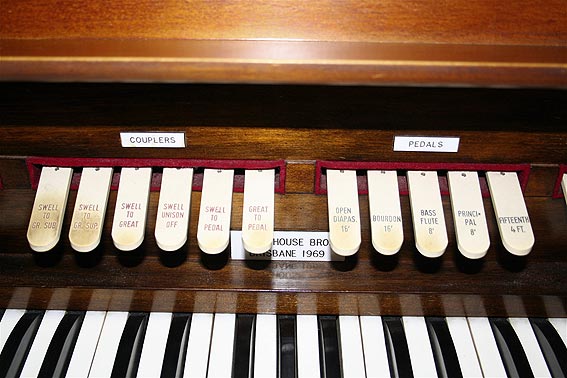
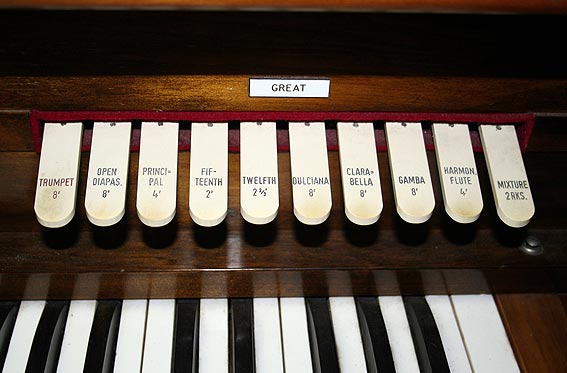
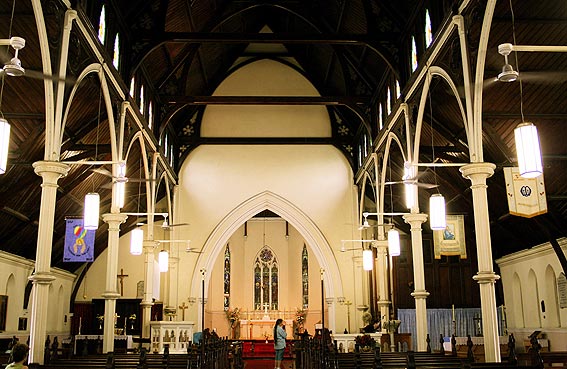

[Photographs by Trevor Bunning (October 2007)]